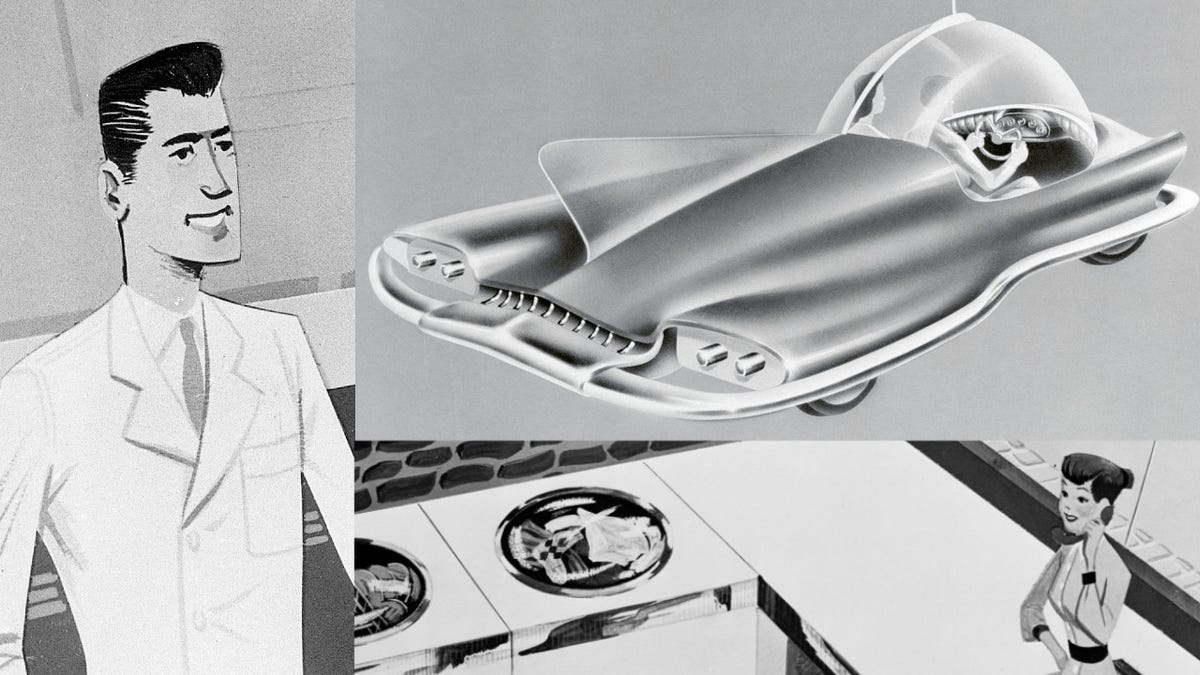How People From 1955 Imagined Technology of the Future - 4 minutes read

In 1955, the U.S. Chamber of Commerce put together a slide show film titled “People, Products and Progress: 1975" to show off what American industry had in store for the technologies of the future.
What did the companies of 1955 imagine they’d be able to deliver twenty years into the future? Sleek streamliner trains, easy electronic checkouts at the grocery store, and even nuclear-powered automobiles.
The Supermarket’s Electronic Eye
“When milady goes food shopping in 1975, there’ll be no lengthy waiting at a check-out counter,” this slide read. “The improvement, pictured here, will be an automatic computer that will price all the items as they pass under an electronic eye.”
The first question some from the 21st century is likely asking with an illustration like this: Where are the barcodes? While the barcode was invented in the late 1940s, they wouldn’t make their way to U.S. supermarkets until the 1970s. How is this “electronic eye” scanning the food? Perhaps it just knows what a carrot looks like and why it’s different from cheddar. Your guess is as good as ours.
Streamliner Train of 1975
The streamliner train of 1975 allowed for quite a view in the form imagined in this illustration from 1955, produced with the help of the Association of American Railroads. The trains were “characterized by lighter weight and a lower center of gravity than today’s cars, plus an ability to negotiate curves at much greater speeds.”
And while it was 1955 already, these trains of tomorrow had been a staple of promises from the 1940s. Our trains today don’t have this many windows. Sometimes it takes quite a while for the future to be delivered, as any hopeful fan of the flying car can attest.
Atomic Car of 1975
“Continuing research by the American Iron and Steel Institute may aid in developing this car equipped with electronic devices which will alert the driver to road conditions far ahead, plus an automatic ‘brain’ that’ll park the car,” this slide read.
But the real surprise? This car was supposed to be powered by atomic energy, not unlike a concept car developed in 1957 called the Ford Nucleon. That huge trunk? That’s where the nuclear reactor goes.
Train Track Layer of the Future
The 1975 train-track-layer, which will “do all construction and repair jobs,” was the promise that even major infrastructure process would be improved through automation. Commercial illustrator and Sunday comics artist Arthur Radebaugh would later borrow this idea from 1955 for his strip “Closer Than We Think” in 1958.
Shopping via Phone by the Automatic Washers
This futuristic design, showing the woman of 1975 making purchases over the phone, was really all about the ease of doing the dishes, the laundry, and anything else needed with the touch of a button.
The 1962 TV show “The Jetsons” would have some fun with this idea years later, but this was a very earnest prediction in the mid-1950s. In fact, if you were reading the Jan. 1955 issue of Scientific American magazine, you saw an ad about laundry that looked identical to this slide.
Double Decker Commuter Train
This double-decker commuter train of 1975, imagined in the U.S. Chamber of Commerce slide presentation from 1955, included the streamlined look that was first popularized in the 1930s. Even the humans of the 1930s were going to be streamlined, sleeker and chicer.
We like to think of retro ideas like this streamlined train as being completely new to the time. But every generation pulls something from the generations of designers that came before it.
Nuclear-Powered Train
It wasn’t just the cars that would be nuclear-powered. This last slide showed a train pulled by an atomic-powered locomotive. Americans were going to get nuclear-powered everything, thanks in large part to President Dwight Eisenhower’s 1953 “Atoms For Peace” initiative, which in the end gave us more illustrations than real modes of transportation.
Source: Gizmodo.com
Powered by NewsAPI.org